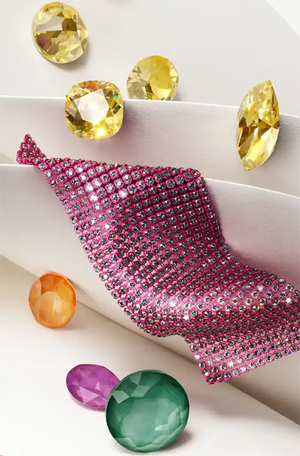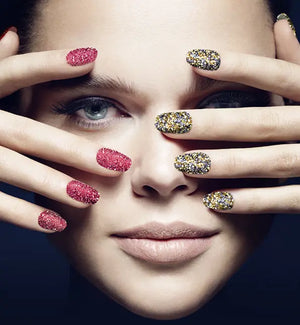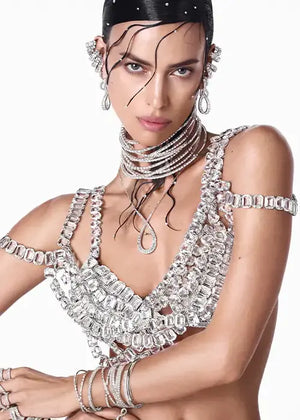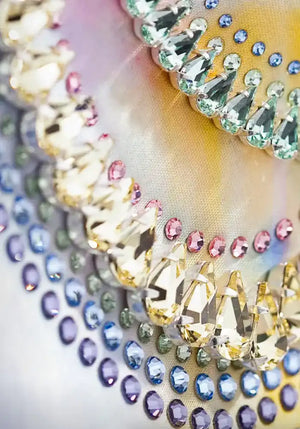
Rhinestones vs. Diamonds: What's the Difference?
That sparkly stone catching your eye might look like a million bucks, but is it actually a diamond or a well-crafted rhinestone? The difference matters—not just for your wallet but for how you'll use it and how long it'll last. Many jewelry enthusiasts and crafters encounter this confusion regularly, and understanding the distinctions can save both money and disappointment.
What Are Rhinestones?
Rhinestones are manufactured gems designed to mimic the brilliance of diamonds without the astronomical price tag. They got their name from the Rhine River in Europe, where quartz pebbles were once collected and cut to create the first "diamond simulants" back in the 1700s.
Common Materials Used
Today's rhinestones bear little resemblance to those river rocks. Most modern versions are made from glass, acrylic, or crystal with a metallic backing that enhances their reflective properties. The highest quality ones—like those from Swarovski—use lead crystal precisely cut with specialized machinery to maximize light reflection.
Vintage rhinestones from the 1950s often display a warmer glow compared to contemporary versions, which typically feature more diamond-like flash and clarity thanks to advanced manufacturing techniques.
Popular Uses of Rhinestones
Walk into any dance competition, and rhinestones appear everywhere—costumes, accessories, even shoes sparkle under the stage lights. They're perfect for these applications because they're lightweight, affordable in bulk, and catch light dramatically from a distance.
Beyond performance wear, rhinestones have found their way into everyday fashion, home décor, and DIY projects. From rhinestone-encrusted phone cases to wedding centerpieces that shimmer with these accessible gems, the applications seem endless. For crafters seeking quality embellishments for crafts, rhinestones offer versatility that diamonds simply can't match due to cost constraints.
What Are Diamonds?
Unlike their manufactured counterparts, diamonds form naturally deep within the earth under extreme pressure and heat over billions of years. Each one is unique—a tiny time capsule with its own internal characteristics and formation story.
Unique Properties of Diamonds
Diamonds earn their reputation through unmatched physical properties. They rank 10 on the Mohs hardness scale—literally the hardest natural substance on earth. This extreme hardness means they resist scratching from virtually anything else.
Their optical properties are equally impressive. The way diamonds refract light creates that distinctive fire and brilliance that no other gemstone fully duplicates. Many people can instantly recognize the difference when comparing a diamond to other stones, even without any gemological training—there's just something distinctive about how diamonds interact with light.
Common Uses of Diamonds
Engagement rings might be the most obvious use for diamonds, but they're far from the only application. Their hardness makes them valuable for industrial cutting tools, while their prestige makes them popular for milestone jewelry pieces meant to last generations.
Diamonds also serve as investments for some collectors, particularly rare colored varieties or stones with historical significance. Unlike most purchases that depreciate immediately, quality diamonds often retain or increase their value over time.
Key Differences Between Rhinestones and Diamonds
Appearance and Sparkle
To the untrained eye, a high-quality rhinestone can look remarkably diamond-like at first glance. The differences become apparent with closer inspection, however. Diamonds display a unique fire—flashes of rainbow colors as they move under light. Rhinestones typically show a more uniform, mirror-like reflection without the same color dispersion.
Rhinestones often appear more consistently brilliant across their entire surface, while diamonds have subtle variations in their sparkle pattern based on their internal structure.
Hardness and Durability
This is where the comparison isn't even close. When a rhinestone and a diamond are dropped on a hard surface, the results tell the story—rhinestones may chip or crack while diamonds typically remain intact. Diamonds can last literally forever with proper care, while rhinestones will eventually show wear from regular use.
The metallic backing on rhinestones can also oxidize or wear away over time, diminishing their sparkle. Diamonds maintain their optical properties indefinitely.
Cost and Value
The price difference is staggering. A single one-carat diamond of decent quality might cost thousands of dollars, while you could buy thousands of rhinestones for the same amount. This makes rhinestones the obvious choice for projects requiring multiple stones or where loss or damage is likely.
Unlike diamonds, rhinestones don't retain value after purchase. They're consumable craft supplies rather than investments, which shapes how and where you might use them.
Testing Methods to Tell Them Apart
For those unsure about what they're looking at, several simple tests can help. Diamonds easily scratch glass, while rhinestones won't make a mark. Diamonds also conduct heat remarkably well—fog from breath disappears almost instantly on a real diamond but lingers on a rhinestone.
For more certainty, jewelers use specialized tools like thermal conductivity testers that can instantly distinguish between the two materials.
When to Choose Rhinestones vs. Diamonds
Budget Considerations
For most decorative purposes, rhinestones make far more financial sense. Wedding centerpieces, for example, can achieve elegant sparkle with high-quality crystal rhinestones without consuming an entire celebration budget.
Diamonds become worth considering when creating heirloom pieces meant to last generations or when the symbolic value outweighs the cost difference.
Purpose and Longevity
Consider how the piece will be used and how long it needs to last. For a dance costume worn for a single competition season, rhinestones are perfect. For a wedding ring worn daily for decades, a diamond's durability becomes a practical consideration, not just a luxury.
Those interested in other diamond alternatives that offer better durability than rhinestones might consider comparing moissanite and diamond options for long-term wear.
Ethical and Sustainability Factors
Some people choose rhinestones specifically to avoid concerns about diamond mining practices. While the diamond industry has made strides with certification programs, some consumers prefer manufactured alternatives for peace of mind regarding ethical sourcing.
Final Thoughts
Both rhinestones and diamonds have their place in the world of sparkly things. Understanding the differences helps make choices that match specific needs, budgets, and values. So whether you’re crafting a showstopping costume or selecting an engagement ring, knowing exactly what you're working with ensures satisfaction with your sparkling creation for exactly as long as you need it to last.







